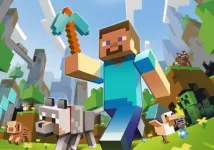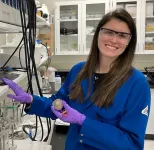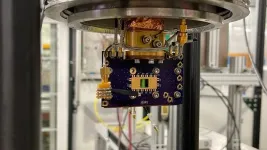(Press-News.org) It’s the globally popular video game that’s captured the attention of more than 141 million active players, but Minecraft can also play a significant role in shaping children’s development, social interactions, and cognitive learning, say researchers at the University of South Australia.
Published in the new book Children’s online learning and interaction, the study found that when children engage in collaborative Minecraft play, they foster teamwork, communication, and social skills as players exchange ideas and problem-solve in real-time.
As Minecraft Education Edition becomes more prevalent in school curricula worldwide, understanding how children interact within these digital spaces is critical for parents and educators.
Author and UniSA researcher Dr Vincenza (Enza) Tudini, says Minecraft can be a powerful tool for learning, creativity and social development.
“From what we see of children’s interactions on Minecraft, it’s far more than just a digital pastime; it’s a virtual playground where children can develop problem-solving skills, collaboration, and language abilities,” Dr Tudini says.
“We also know that Minecraft is a pro-social game with players demonstrating greetings and positive play evaluations as they interact with each other. As they play or watch videos, they’re growing their language skills, and increasing their digital literacy.
“Team and problem-solving skills are also prominent in Minecraft. Unlike traditional video games that tend to focus on competition and scoring points, Minecraft is an open-ended experience that encourages children to build, explore, and interact, with players often working together to achieve common goals.
“We also see many instances where knowledgeable players are actively guiding less experienced players through challenges. Such scaffolded-learning supports creative thinking, motivation and growth, and because it’s peer-delivered, it builds team-skills and confidence.”
Despite Minecraft offering rich learning opportunities, it also comes with challenges – especially in open online environments.
“All online spaces have safety risks. While Minecraft promotes positive social interactions, public servers can expose children to online risks such as bullying or interactions with unknown players,” Dr Tudini says.
“Ensuring children’s safety and maximising the game’s educational potential requires active involvement from both parents and educators. We need to teach children about safe gaming practices, encourage play with known friends, and monitor content to ensure a safe gaming experience.
“By adopting safe gaming practices and integrating Minecraft into learning environments, we can help children harness its benefits while navigating the digital world responsibly.”
Recommendations for Parents
Encourage collaborative play with known friends or siblings to enhance social skills and teamwork.
Opt for family-friendly or private servers to reduce risks associated with public multiplayer gameplay.
Monitor YouTube and online content to ensure channels are appropriate.
Teach online safety, set boundaries about sharing personal information, and encourage respectful online communication.
Ensure a healthy balance between screen time with other offline activities
Recommendations for Schools:
Minecraft Education Edition offers structured lessons like coding, mathematics, and environmental science. Teachers can use the game to engage students in creative learning.
Promote digital citizenship by teaching online etiquette, cyber safety, and responsible gaming.
Encourage constructive collaboration that require teamwork and problem-solving.
…………………………………………………………………………………………………………………………
Contact for interview: Dr Vincenza (Enza) Tudini E: Enza.Tudini@unisa.edu.au
Media contact: Annabel Mansfield M: +61 479 182 489 E: Annabel.Mansfield@unisa.edu.au
END
Minecraft: a gamechanger for children’s learning
2025-02-11
ELSE PRESS RELEASES FROM THIS DATE:
Presidential awards spotlight naval research excellence
2025-02-11
WASHINGTON, D.C. – An alternative energy mechanical engineer, two aerospace engineers, and a corrosion research engineer received the highest honor bestowed to early career U.S. government scientists and engineers.
These four U.S. Naval Research Laboratory (NRL) researchers each received a Presidential Early Career Award for Scientists and Engineers (PECASE) for their research on next generation energy storage solutions, solid fuel combustion for use in high-speed propulsion devices, solving large-scale ...
SETI Institute names first Frank Drake Postdoctoral Fellow
2025-02-11
February 11, 2025, Mountain View, CA -- The SETI Institute awarded the first Frank Drake Postdoctoral Fellowship to Dr. Anastasia Yanchilina. Yanchilina will focus on distinguishing biosignatures from false positives across space and time. Her research combines experimental and analytical research to refine biosignature detection techniques. She will conduct lab experiments to generate key mineral analogs and study Earth’s extreme environments to understand what potential signs of life to look for on other planets.
“It has long been my scientific dream to explore whether life exists ...
From photons to protons: Argonne team makes breakthrough in high-energy particle detection
2025-02-11
Particle detectors play a crucial role in our understanding of the fundamental building blocks of the universe. They allow scientists to study the behavior and properties of the particles produced in high-energy collisions. Such particles are boosted to near the speed of light in large accelerators and then smashed into targets or other particles where they are then analyzed with detectors. Traditional detectors, however, lack the needed sensitivity and precision for certain types of research.
Researchers at the U.S. Department of ...
Cancer’s ripple effect may promote blood clot formation in the lungs
2025-02-11
Blood clots form in response to signals from the lungs of cancer patients—not from other organ sites, as previously thought—according to a preclinical study by Weill Cornell Medicine, Memorial Sloan Kettering Cancer Center and University of California San Diego Health. Clots are the second-leading cause of death among cancer patients with advanced disease or aggressive tumors.
While blood clots usually form to stop a wound from bleeding, cancer patients can form clots without injury, plugging up vessels and cutting off circulation to organs. The study, published Feb. 11 in Cell, shows that tumors drive clot formation (thrombosis) by releasing ...
New UVA clinical trial explores AI-powered insulin delivery for better diabetes care
2025-02-11
For people living with Type 1 Diabetes (T1D), keeping blood sugar levels in check is a constant challenge. A new clinical trial at UVA is aiming to simplify diabetes management by testing an innovative AI-powered device designed to improve automated insulin delivery.
The trial is co-led by several School of Data Science faculty, including Assistant Professor of Data Science Heman Shakeri; Boris Kovatchev, founding director of the UVA Center for Diabetes Technology, a professor at the School of Medicine and professor ...
New technology could quash QR code phishing attacks
2025-02-11
The ubiquitous QR (“quick response”) codes that appear on everything from parking pay stations to soda cans and promotional flyers have become an increasingly popular target for cybercriminals to exploit through QR code–based phishing attacks, also known as “quishing.” Bad actors will place phony QR codes that direct smartphone users to enter their sensitive private information in fake websites masquerading as bank websites, parking enforcement offices, or other seemingly ...
Study reveals direct gut-brain communication via vagus nerve
2025-02-11
A new study in an animal model provides direct evidence for the role of the vagus nerve in gut microbiome-brain communication, addressing a critical gap in the field.
The research, led by Kelly G. Jameson while a PhD student in the Hsiao Lab at UCLA, demonstrates a clear causal relationship between gut microbiota and vagal nerve activity.
While the vagus nerve has long been thought to facilitate communication between the gut microbiome—the community of microorganisms living in the intestines—and the brain, direct evidence for this process ...
MSU expert: Using light to hear biology
2025-02-11
Images
Elad Harel is used to shining a light on the mysteries of the natural world.
Working at the cutting-edge of ultrafast spectroscopy — the application of short laser pulses to analyze the dynamics of molecules — the Michigan State University associate professor’s research aims to reveal how microscopic phenomena impact large complex systems.
One promising frontier Harel has been working on is the development of new methods of microscopy that will allow researchers to observe molecular and atomic landscapes in motion rather than through static imagery. Such work has earned Harel MSU’s 2023 ...
“I can’t hear you, I’m too stressed”: Repeated stress in mice reduces sound perception
2025-02-11
After a week of stress, mice show changes in how their brains process sound, reducing how well they perceive loud noises, according to a study published February 11th in the open-access journal PLOS Biology led by Ghattas Bisharat, from the Ben-Gurion University of the Negev in Israel, and colleagues.
Repeated stress has negative impacts on mental health that can go beyond psychiatric disorders. They can also cause changes in how we perceive the world, making us jump at loud noises, or become easily irritated by scratchy sweaters or offensive odors. To understand how repeated stress can impact how the brain processes sensory information, the authors ...
Chronic stress affects how brain processes sound in mice
2025-02-11
BEER-SHEVA, Israel, February 11, 2025 – Chronic stress changes the way our brain processes sounds, according to new research conducted on mice at Ben-Gurion University of the Negev. For instance, sounds need to be louder during chronic stress to trigger similar responses.
Chronic stress is known to impact learning and decision-making, but could it also affect how we hear? Dr. Jennifer Resnik from Ben-Gurion University’s Department of Life Sciences set out to find whether stress influences basic brain functions, ...







